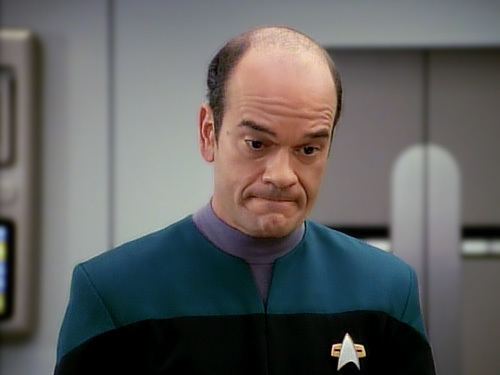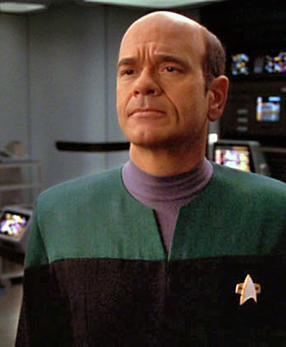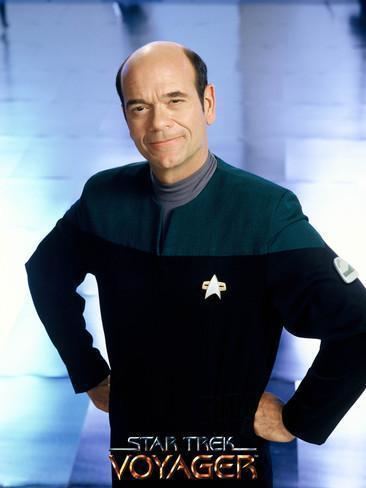Species Hologram Fictional universe Star Trek | Occupations Emergency doctor | |
 | ||
Similar | ||
The Doctor, an Emergency Medical Hologram Mark I (or EMH for short), is a fictional character from the television series Star Trek: Voyager, played by actor Robert Picardo. The character also appeared in the now-closed Star Trek: The Experience amusement exhibition at the Las Vegas Hilton.
Contents
- Fictional character biography
- Emergency Command Hologram
- Backup copies
- Name
- Characteristics
- Emergency Medical Hologram
- Enterprise E EMH
- Casting
- References

Fictional character biography

The Doctor began his service on the USS Voyager as the standard Emergency Medical Hologram built into almost every newer Starfleet ship's sickbay. The EMH is for use should the ship's doctor be incapacitated. In the series' first episode, Voyager's Chief Medical Officer, along with his Vulcan nurse, were killed, necessitating extended use of the EMH. The EMH eventually developed his own personality, although he generally maintained his acerbic wit, and irritating "version one" bedside manner. As he was originally intended as a temporary medical backup system, not as a digital life form, Voyager's journey strains his programming to some limits. His cohorts were Kes and Tom Paris, both of whom functioned as nurses.
Attempting to develop a realistic personality, The Doctor not only manufactured a holographic family, he had an increasing number of other "human" experiences. This resulted in The Doctor's program evolving to become more lifelike, with emotions and ambitions. He developed meaningful and complex relationships with many members of the ship's crew. The Doctor also developed talents as a playwright, artist, and photographer, and even became a connoisseur of opera.

A recurring theme was the ethical aspects of an artificial, yet apparently sentient, being. In "Latent Image" treating two patients with an equal chance of survival, with only enough time to treat one, The Doctor chose Harry Kim, a friend. The other patient, Ensign Jetal, died. The Doctor was overwhelmed with guilt, believing that his friendship influenced his choice. When the stress nearly led to his program breaking down, Captain Janeway had his memories of these events deleted. When The Doctor later discovered clues as to what had happened, Captain Janeway was convinced by him and others that he had a right to learn to come to grips with the guilt in the manner of any other sentient being rather than be treated merely as a defective piece of equipment.
The Doctor submitted a holonovel titled Photons Be Free to a publisher on Earth, detailing the manner in which holograms were sometimes treated by Starfleet. His characters were closely based on Voyager's crew, but exaggerated to appear more intense and vicious, creating fears among the crew their reputations would be ruined. Tom Paris convinced The Doctor to make adjustments without sacrificing his theme. The Doctor lacked legal rights as Federation law did not classify him as a "sentient being". Thus he was forbidden to make any subsequent changes to the holonovel. Captain Janeway's efforts resulted in The Doctor being accorded the status of "artist", (though not a "person"). This permitted him to rewrite the novel. Four months later, it was known throughout the Alpha Quadrant as a very thought-provoking piece of work. Several other EMHs, now relegated to mining duty, experienced the novel.
The Doctor's standard greeting was "Please state the nature of the medical emergency" when activated, though later modified to say whatever he chose. He was later given the ability to activate and deactivate himself.
The Doctor later acquired a mobile holographic emitter from the 29th century. Although he had previously been confined to Sickbay or the Holodeck, the mobile emitter allowed The Doctor to move about freely, making him ideal for missions where the environment would be harmful or otherwise fatal to the crew. In one notable incident, when an away team was trapped on a radioactive planet, The Doctor was able to infiltrate the people and almost single-handedly rescue the team because, as he pointed out, being a hologram renders him immune to the radiation, stating that "being a hologram does have its advantages."
The Doctor's programming evolved to the point where he fell in love with Seven of Nine, though she did not reciprocate. In an alternate future episode, "Endgame", The Doctor finally adopts a name (see below) and marries a human female named Lana.
In the final episode of Star Trek: Voyager, a future version of Janeway also informs him of his later invention of a device known as a 'synaptic transceiver', something that fascinates The Doctor; he's cut off by the 'present' Janeway, who is abiding by the Temporal Prime Directive, before he can learn more.
Emergency Command Hologram
The "Emergency Command Hologram", aka "ECH", is first coined by The Doctor in the episode "Tinker, Tenor, Doctor, Spy", in which he creates a program which allows him to daydream.
In these grandiose daydreams, The Doctor adds routines which allow him to take command of Voyager in the event of the command crew being disabled.
A dramatic morph transformation occurs changing his uniform from medical blue to command red, his rank pips subsequently appearing. The daydreams are picked up by a Hierarchy vessel in a nearby nebula and believed to be real events.
Once the crew discover that The Doctor is daydreaming they use the holodeck to view his dreams, including the one expressing his desire to be an Emergency Command Hologram. Captain Janeway promises to consider his proposal.
The Doctor soon gets the opportunity to live out his daydreams as, with the assistance of the crew, he pretends to be in charge to neutralize a war fleet.
The ECH made its debut the following season in "Workforce", in which after an incident with a subspace mine that releases a great amount of tetryon radiation, the crew is forced to abandon ship. To keep the ship moving The Doctor takes over the command functions.
In the episode "Renaissance Man", against the wishes of the crew, The Doctor uses his ECH program to eject the warp core.
Backup copies
The Doctor's program required a custom-built photonic processor, and Starfleet outfitted Voyager with only two. This hardware itself also could not be replicated, hence the Doctor could not be easily backed up, restored, or copied.
Voyager's computers could not help run his photonic program, and could not contain a usable backup of its image. The Doctor's entire program used 50 million gigaquads - episodes "Lifesigns" and "The Swarm" mention these limitations. The episode "Living Witness" depicts a future Delta Quadrant civilization building a museum around Voyager artifacts, including its redundant EMH photonic processor.
Name
A recurring theme in the Doctor’s life was his lack of a proper name. Starfleet did not assign a name and initially the Doctor maintained that he did not want one. In season 1 episode 6, “Eye of the Needle,” the Doctor requests a name immediately before credits roll. Later, he adopted such names as 'Schweitzer' (after Albert Schweitzer), ‘Shmullus’ (by Vidiian patient Dr. Denara Pel), ‘Van Gogh,’ ‘Kenneth,” ‘Jones’ and several others. His friends suggest the famous historical Earth doctors "Galen" and "Spock." The captioned dialog of early episodes, and early promotional material for the series premiere, referred to him as ‘Dr. Zimmerman,’ after his creator Lewis Zimmerman. In the series finale, an alternate future timeline is shown where he has chosen the name Joe after his new wife’s grandfather (and having Tom Paris jest, "It took you 33 years to come up with 'Joe'?" in response).
Characteristics
Before the arrival of the mobile emitter, The Doctor's holo-program was confined to Sickbay, holodecks, and other areas equipped with holographic systems.
Depending on the availability of suitable holographic patterns and the capacity of his pattern buffers, The Doctor can alter his appearance.
The Doctor is also able to download his program and personality subroutines into a humanoid with Borg implants, indirectly 'possessing' that individual and gaining control over its 'host' body. Such is the case when he was forced to hide within the body of Seven of Nine.
Emergency Medical Hologram
The EMH is a holographic computer program designed to treat patients during emergency situations, or when the regular medical staff is unavailable or incapacitated. EMHs are a standard feature onboard all Starfleet ships, but they are there only to supplement the living medical crew, not replace it. Programmed with all current Starfleet medical knowledge, The Doctor and all Mark I programs are equipped with the knowledge and mannerisms of historic Federation doctors, as well as the physical appearance of their programmer Dr. Lewis Zimmerman. Zimmerman, along with the EMH, appeared in the Star Trek: Deep Space Nine episode Doctor Bashir, I Presume?, in which the former was in the process of trying to upgrade Starfleet's EMH programs to LMH, i.e. Long-term Medical Hologram, status.
There has been only one update to the Mark I seen on screen, the Mark II played by Andy Dick in the episode "Message in a Bottle", which supposedly had a "better" bedside manner than the Mark I, as well as possibly some updated medical information. However, later episodes mention that further versions of the EMH exist.
Enterprise-E EMH
Picardo had a minor role in the movie Star Trek: First Contact, where he played the emergency medical hologram of the USS Enterprise-E. Doctor Beverly Crusher activates him, albeit reluctantly, as a means of distracting the Borg while she and other crew members escape from the besieged sickbay. He replies, "I'm a doctor, not a doorstop", an homage to Doctor McCoy's catchphrase line "I'm a doctor, not a ..." (The Doctor also made this reference several other times, on Voyager.) Nevertheless, when the Borg do break in, he does attempt to distract them by noting that Borg implants can cause skin irritation and offering to prescribe an analgesic cream. Although the Borg would be unable to harm or assimilate him, he still appears intimidated as they advance upon him.
His reference to an analgesic cream in this scene was reprised in the PC video game Star Trek Voyager: Elite Force.
Casting
Picardo initially auditioned for Neelix. Despite Ethan Phillips getting the part, Picardo was asked by the producers to come back and audition for The Doctor — something that shocked him, because usually actors would be passed over completely. During his audition for the role of The Doctor, Picardo was asked only to say, "Somebody forgot to terminate my program." However, he then ad libbed, "I'm a doctor, not a nightlight!" (Picardo was initially afraid that he may have ruined his chances—ad libbing, he explained, was something that one just "did not do" in an audition.)
